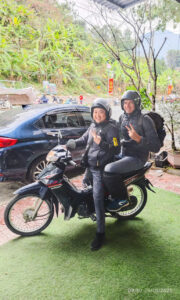Ensuring your well-being during your trip to Ha Giang is crucial. The region, while stunning, does come with its own set of health considerations ranging from food hygiene to local wildlife. Here’s what you should know to have a safe and enjoyable journey.
Food & Hygiene
Street food and local delicacies are an essential part of the Ha Giang experience. However, it’s important to exercise caution. Always opt for freshly cooked food and drink bottled or boiled water. If you have a sensitive stomach, it might be wise to carry antidiarrheal medication.

Mosquitos
Ha Giang is not known for mosquito-borne diseases like malaria or dengue fever, but it’s always good to be cautious. Wearing long sleeves and trousers during dusk and dawn, using insect repellent, and sleeping under mosquito nets in more rural areas can help you avoid bites.
Stray dogs
While not a significant concern, you might encounter stray dogs in Ha Giang. It’s advisable to avoid contact, as rabies is a concern in some areas of Vietnam. If you’re bitten, seek medical attention immediately for proper treatment.
Wildlife
As a mountainous region, Ha Giang is home to various species of wildlife. Though encounters are rare, it’s crucial to know what to do if you come across snakes or other potentially dangerous animals. Keep a safe distance, make slow movements, and do not provoke them.
Hospitals
Medical facilities in Ha Giang are limited compared to larger cities. It’s a good idea to know the location of the nearest hospital and have a basic understanding of how to get there. In case of serious medical issues, you might have to be evacuated to Hanoi, which can be time-consuming and costly.
First Aid Kit Essentials
Carrying a basic first aid kit can be a lifesaver. Essentials should include antiseptic wipes, bandages, pain relievers, antidiarrheal medication, and any prescription medications you may need. It might also be useful to have rehydration salts and anti-allergy medication.
Here’s some tips for NorthStar travellers
- Consider an Easy Rider
If you’re not experienced with motorbike riding or unfamiliar with mountainous terrains, hiring an Easy Rider can be a smart choice. These local experts can navigate the challenging roads, offer cultural insights, and take you to hidden spots you might otherwise miss.

- Recommended Apps for translation and navigation
Apps like Google Translate can be indispensable for communicating, especially in remote areas where English is not widely spoken. For navigation, consider offline map apps like Maps.me or Google Maps’ offline feature, so you’re not reliant on an internet connection.
- Check your travel insurance
Before embarking on your journey, make sure your travel insurance covers motorbike riding and any possible medical emergencies in Vietnam. Read the policy carefully, especially the fine print, to ensure you’re adequately covered.
- Common phrases for emergency
Learning some essential Vietnamese phrases for emergencies can be extremely helpful. Some basic ones include “Cứu tôi!” (Help me!), “Tôi bị thương” (I am injured), and “Bệnh viện ở đâu?” (Where is the hospital?).
- Check the weather
Weather conditions can change quickly in mountainous regions. Always check the weather forecast before setting out and plan your trip accordingly. Rain can make the roads slippery and fog can reduce visibility drastically.
- Equip proper safety gear
Wearing appropriate safety gear is crucial. This includes a good-quality helmet, knee and elbow pads, and a high-visibility jacket or vest. Make sure your gear fits well and is in good condition.
- Maintain your motorbike
Before starting your journey, thoroughly check your motorbike for any maintenance issues. Make sure the brakes are working, the tires are inflated, and the lights and signals are functional.
- Be mindful of the time
Plan your day so that you’re not riding in the dark. Mountain roads can be treacherous, and lack of light will only compound the risks. Try to reach your day’s destination well before sunset.
- Carry essential supplies
Pack a first aid kit, enough water, and some non-perishable food items when you’re on the road. You may not always have quick access to shops, especially when driving through remote areas.

 +84 91 322 2269
+84 91 322 2269